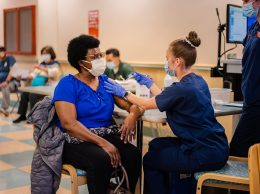As drones migrate from the military space into the private sector, their potential uses reach far wider than the home delivery efforts that made headlines a year ago.
Earlier this month, the Federal Aviation Administration granted permits for limited drone operations to 13 companies, opening a small window at the agency, which currently limits drones to government entities and hobbyist use.
The FAA has received 167 requests for permits from commercial entities, including the National Association of Realtors and film production companies. With Congress’ legislation on the matter lagging, other agencies are seizing the initiative.
NASA’s Ames Research Center in the Bay Area is building a system to provide air traffic control for drones, and they’ve invited private industry to participate. Santa Barbara-based startup PixiePath is one of 25 companies working on the NASA program.
PixiePath founder and CEO Bryan Field-Elliot said he hopes the results will provide drones with a system that eventually resembles the predicable flight plans in place for manned aircraft.
“They’re going to build this and then hand it over to the FAA, but it’s probably two or three years out,” Field said. “It’s an interesting long-range thing, but meanwhile it doesn’t really help us. There’s nothing there now.”
Field launched PixiePath in August to provide a way for commercial drone operators to coordinate their craft through a cloud platform. He previously had two companies that built cloud platforms to manage physical devices that weren’t built for the cloud, and with the rise of drones he saw a vast opportunity for industry applications.
“The hardware is innovating at a really fast pace; the software on top of it, not really,” Field said. “All the drone manufacturers, they’re thinking about one unit and not really participating in the Internet in general; we’re building tools to connect them to the Internet, and then do things with it.”
The PixiePath platform allows drones to communicate with each other and transmit information to multiple connected devices for the first time. The company is about to release an early prototype and is still seeking funding but has already been in talks to work with 65 companies across the globe. Its two most promising leads are billion-dollar civil engineering companies based in Canada, Field said.
“We’re a long way away from the FAA allowing things like delivery, but between agriculture and construction, there’s a lot of stuff in between that people are interested in doing that is not well served by software companies,” he said.
For now, the company is concentrating its efforts in construction, search and rescue, security and first response. An example of what Field hopes to see is an app that campuses use to allow students to use their phones to summon security if they feel unsafe.
“Instead of a cop coming 10 minutes later, what if a drone came 10 seconds later with flood lighting?” Field asked.
The Association for Unmanned Vehicle Systems International estimates that the integration of unmanned aerial vehicles, or UAVs, into national air space will carry an economic impact of more than $13.6 billion and create 70,000 jobs in the first three years — with the bulk of growth in California.
While that sort of impact is not yet at hand, drones have already arrived on one tri-county campus with Northrop Grumman’s donation of two UAVs to CSU Channel Islands.
CSUCI Senior Research Officer Jason Miller said the university is currently working with the FAA to gain approval to use its craft; he hopes students will be able to soon learn to operate the aerial systems and use them as research tools or platforms to help faculty.
“It’s a perfect opportunity to prepare students entering the technology sector. There’s a lot of room for creativity,” Miller said. “We’re exited that we can support this industry in Ventura County, and we hope we can support businesses that are expanding into this space, and we’re looking for local commercial partners.”
It’s unclear when the FAA will clear the UAVs for flight. But, once they are, the campus’ students will be at the forefront of furthering drone’s widespread use, according to Mark Mendenhall, a principal engineer at Northrop Grumman’s facility in Camarillo.
“There are a lot of key technologies that need to be proven out before [unmanned aerial systems] can operate in national air space, and I expect that CI students may participate in studying, prototyping and evaluating some of these critical needs,” Mendenhall said in a press release. “The integration of sensors focusing on marine-wildlife monitoring, first-responder needs, or those aligned with search and rescue or fire-fighting needs are areas of opportunity that students are likely to explore.”
But until then, the school will join the regulatory waiting game.
“In the U.S. it’s really backward,” PixiePath’s Field said. “If you take some photos of a wedding for free, it’s fine. If you’re a wedding photographer and you charge for it, you can’t. Same wedding, same drone.”
As a result, the vast majority of companies currently using drones are just trying their luck. “It’s not like the FAA has a police force,” Field said. “People wanting to do business with drones, they want regulations to comply with. They want to be safe; they don’t want to give their industry a bad name. But a hobbyist is going to be a lot more reckless because they don’t have a business to protect.”
“It’s the source of frustration for a lot of people who want to start a business around the UAV,” CSUCI’s Miller said. “Where do you draw the line between commercial and hobby use?”
Field hopes PixiePath can help push compliance forward as a byproduct of its business model.
“For example, this large civil engineering firm — they’re global, but their Vancouver office wants our help to build up a drone practice, where they might be flying as many as 100 by the end of next year,” he said.
“One of the biggest things they want is to be able to prove they’re complying with the Canadian regulations. So every time a pilot goes somewhere with one of these things, they want to be able to open a form on a tablet or phone, fill out the person’s name, the time of day, and where they are, and save that in a log for auditing purposes. They want to demonstrate that to the Canadian authorities, and then fly the thing, and then pipe the video up to the cloud for people far away to see. Creating that capability is a lot easier than flying robotics, so we’ll do it.”






 Print
Print Email
Email

















